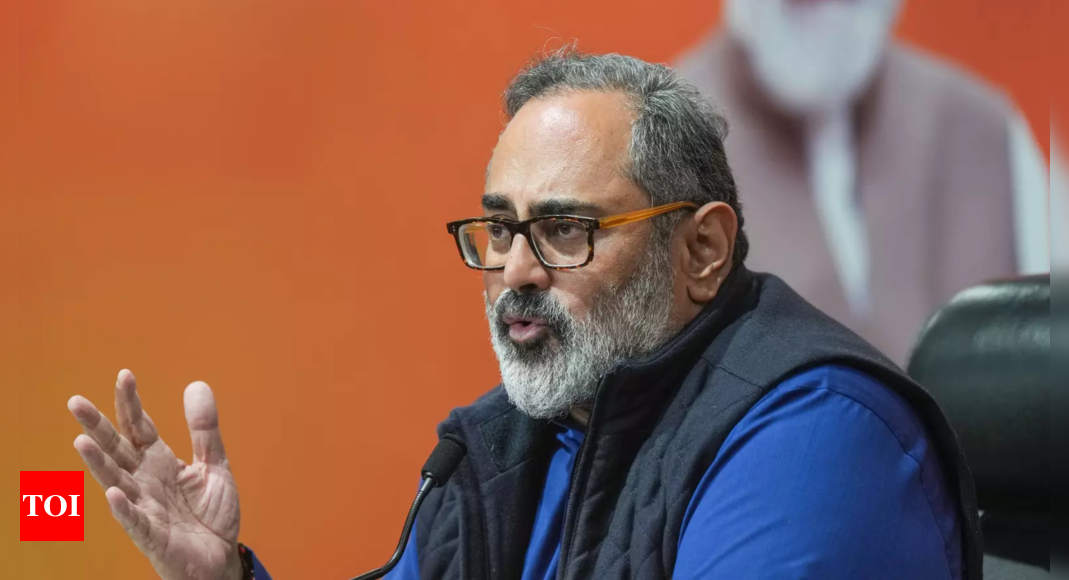[ad_1]
MUMBAI: India has taken the lead to develop a draft global AI regulatory framework which will be discussed and debated in June-July this year, union minister of state for electronics and IT Rajeev Chandrasekhar said virtually addressing stakeholders at the 32nd edition of the Nasscom India & Leadership Forum (NTLF) held in Mumbai on Tuesday.
“It’s impossible to regulate the harm caused by AI and the internet because these are extra jurisdictional — the victim in one jurisdiction, the perpetrator in the other and the harm is committed in a third jurisdiction.There is a need for alignment around principles that will be the underpinning of this global framework and India must lead the charge in creating the draft framework,” he said. Chandrasekhar said the framework will be discussed at the Global Partnership on Artificial Intelligence (GPAI) event which will be held this year. GPAI is a multi-stakeholder initiative with 29 member countries aiming to bridge the gap between theory and practice on AI by supporting research on AI-related priorities. India is the lead chair of GPAI this year.
As the government is building guardrails for generative AI, Chandrasekhar said it has become an imperative with safety and trust at the heart of it. “This (GPAI event) is so that we can agree on these guardrails and what the nature, form and shape of these rules and these protocols will be. Every platform must be legally accountable for any harm it causes or enables, and as a corollary, it should not enable criminality. Instead of responsible and ethical AI, the narrative should be safe and trusted AI,” he said.
Chandrasekhar said 900 million Indians online and 1.3 billion people will be connected to the global internet soon, providing India both an opportunity and a responsibility to collaborate on regulations to create legal guardrails that protect consumers and citizens. “We are essentially taking the framework and retrofitting it to deal with the complexity and impact of AI in terms of safety infrastructure. We expect AI to be a kinetic enabler of the digital economy. But we want to ensure legal guardrails so that AI is safe and trusted. It cannot trespass and cause harm to people and businesses—it’s also about indirect accountability of those who use the AI platform,” he added.
“It’s impossible to regulate the harm caused by AI and the internet because these are extra jurisdictional — the victim in one jurisdiction, the perpetrator in the other and the harm is committed in a third jurisdiction.There is a need for alignment around principles that will be the underpinning of this global framework and India must lead the charge in creating the draft framework,” he said. Chandrasekhar said the framework will be discussed at the Global Partnership on Artificial Intelligence (GPAI) event which will be held this year. GPAI is a multi-stakeholder initiative with 29 member countries aiming to bridge the gap between theory and practice on AI by supporting research on AI-related priorities. India is the lead chair of GPAI this year.
As the government is building guardrails for generative AI, Chandrasekhar said it has become an imperative with safety and trust at the heart of it. “This (GPAI event) is so that we can agree on these guardrails and what the nature, form and shape of these rules and these protocols will be. Every platform must be legally accountable for any harm it causes or enables, and as a corollary, it should not enable criminality. Instead of responsible and ethical AI, the narrative should be safe and trusted AI,” he said.
Chandrasekhar said 900 million Indians online and 1.3 billion people will be connected to the global internet soon, providing India both an opportunity and a responsibility to collaborate on regulations to create legal guardrails that protect consumers and citizens. “We are essentially taking the framework and retrofitting it to deal with the complexity and impact of AI in terms of safety infrastructure. We expect AI to be a kinetic enabler of the digital economy. But we want to ensure legal guardrails so that AI is safe and trusted. It cannot trespass and cause harm to people and businesses—it’s also about indirect accountability of those who use the AI platform,” he added.
[ad_2]
Source link


